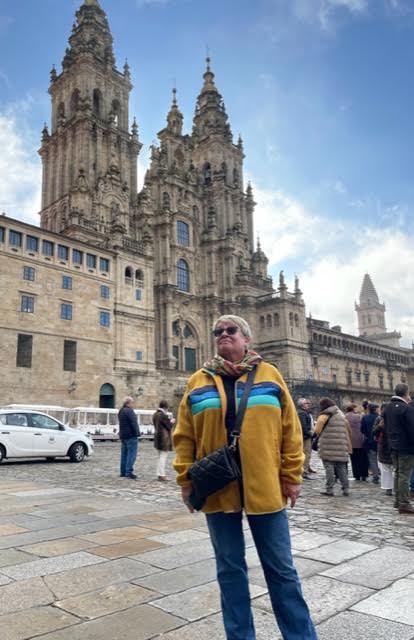The True Story of My First Attempt at Walking Camino Ingles in Spain
Guest Column by Pia Hallenberg
About a year before we left, a friend asked if anyone was interested in walking the Camino Ingles in Spain. An 80-year-old relative of his had done it several times, he said.
Always a traveler, and just on the south side of 55, I quickly said yes. I’d never done anything like that, nor could I walk the 75 miles (120 kilometers) from Ferrol in northwestern Spain to Santiago de Compostela, but there was time to train.
Also, I’m not Catholic, so I had to wrap my mind around making a pilgrimage for something other than traditional faith. I decided that my reflection was going to be about my work as an independent freelance writer – what would my next steps be? Am I on the right path? And then I had the secondary goal of staying off the computer for seven days in a row.
The Meaning
When people talk about walking the Camino, they mean many different things. There are more than 250 recognized Caminos and seven main routes, including Camino Frances (485 miles or 780 kilometers) and Camino Primitivo, aka The Original Way (199 miles or 320 km). Some Camino routes traverse the Pyrenees or the Alps. Compared to that, the Camino Ingles seemed very manageable for first timers.
Caminos are pilgrim routes which people have walked to sacred places since the earliest times. Today, some choose to do their Camino authentically, carrying everything they need in a backpack and sleeping in hostels (Albergues) along the way.
“The Camino provides,” they say, heading out toward their next destination without a room reservation. These pilgrims have much more faith than I can muster as a loose-hanging Lutheran with a robust agnostic bend.
Doing it My Way
I nixed the hostel idea early on. I did not want to sleep in bunkbeds next to 30 strangers – and I adore plenty of hot water in a private bathroom, especially when I’m tired.
We divided the distance into stages of a little over 10 miles each. I thought of it as walking a Bloomsday every day for seven days. A group of friends eagerly committed to going along, and one saint organized the group’s lodging with the help of a Camino travel agency.
We read books and watched movies about the Camino. I started walking for real. Our group dwindled. I kept walking. Soon, we were down to five pilgrims. I added yoga twice a week and swimming.
Getting the Gear
I owned no hiking gear. I’ve always been incredibly intimidated by places like REI, where people speak trekking language, and everyone is sun tanned from mountain climbing. I’m afraid of heights.
The good news is that there is no need to go gear crazy for Camino Ingles – it holds no rivers to traverse or mountain peaks to climb – and much of the walking is on paved roads, but I wouldn’t recommend doing it in jeans.
I picked up a well-fitted backpack, waterproof trail running shoes, wool running socks, hiking pants, and t-shirts. Cotton, I was informed, is the cloth of death when you hike. Two Smart Wool shirts were added at the last minute because October could be cold and rainy.
Yeah, that: I also spent $200 on rain gear.
The bill for gear soon matched the bill for the plane ticket.
And off we went.
The Beginning
Ferrol is a charming port city on the northwest coast of Spain. It’s medieval with narrow cobblestoned streets, small churches everywhere, and ancient buildings leaning here and there. Little nods to the Camino are everywhere you go: the telltale sign of a scallop shell, the way-finding symbol for the Camino de Santiago (the Way of St. James), and old inscriptions in bricks and walkways.
We went to bed with open windows and our bellies full of delicious garlic potatoes. I could barely sleep the night before our walk began, partly because I was excited and partly because I was busy ignoring the pain that was gnawing in my throat.
The first day of walking took us out of Ferrol through an industrial area and by a massive naval base, and then on to Neda, where we settled in for the night. I’d gasped for air all day and the coughing that followed my wheezing grew nasty. While everyone else feasted on fabulous Iberian ham, eggs, potatoes, and beers, I was not hungry at all. I went to bed shivering, hugging my inhaler. Surely this would pass, I thought.
The following day, I lightened my backpack as much as possible before we headed toward Pontedeume. It was one of the longer legs of the walk – the weather was gray and drizzly, but it wasn’t cold. We walked along busy roads, and just like each coughing fit tore at my lungs, each step felt more and more difficult. I didn’t like my inner dialogue about how I was now holding up the group. I struggled.
Those Who Went Before
I started thinking of the thousands of medieval pilgrims who’d walked the path before me, exposed to typhoid and the bubonic plague, relying only on the food given to them, sleeping where they fell, many going barefoot or in simple sandals. If they could survive, surely so could I, but I was getting sick.
“In the hundreds of years of the Camino, you surely aren’t the only pilgrim who’s gotten sick,” messaged a friend. “Get some rest. It will pass.”
Once at the hotel, I took a long soak in water as hot as it would get and admitted that I most likely had COVID.
Sickness and Rest
When the rest of the group left for Betanzos the following day, I went shopping for facemasks, a home test kit, and cough syrup. I returned to the windowsill in my hotel room, watching the rain stream down the panes. I rested my burning forehead against the cold glass and felt utterly sorry for myself. I was so disappointed I cried.
I took a cab to our next hotel, a gorgeous bed and breakfast outside Bruma. I slept. It rained. I was thankful we were staying two nights in the same place.
After two days of sleep, I finally had some dinner and decided I was going to try and walk again Saturday morning. As we walked off on this second to last day the fog was just lifting, as we made our way across rolling green hills below white cotton puff clouds sailing across a bright blue sky. The views were stunning like an old English painting. Little farms dotted the area. Chestnut trees leaned in over the path and I cried again, but happy tears.
I felt good. This was what walking the Camino was supposed to feel like. I still had to rest frequently, but I kept putting one foot in front of the other to our last stop before Santiago: Sigueiro.
There, I crashed in bed and took a four-hour nap before attempting dinner, quickly followed by another night of dead sleep. Sunday morning, I was in good spirits as we headed off on the last leg into Santiago de Compostela.
Success.
I want to tell you that when I finally saw the Santiago de Compostela Cathedral, I felt something big and significant. And I did feel a sense of accomplishment, matched by an equal sense of disappointment. While my friends got their pilgrim passports stamped and approved, I waited outside, leaning up against the sturdy Romanesque body of the towering anno 1211 cathedral.
Well, I did part of it, I thought to myself, watching all the other peregrinos stream into the plaza in front of the cathedral. And I will come back to finish it – currently making plans for 2025.
The views expressed in this opinion column are those of the author and do not necessarily reflect the views of FāVS News. FāVS News values diverse perspectives and thoughtful analysis on matters of faith and spirituality.








